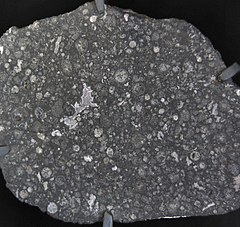| Allende | |
|---|---|
 Allende fragment | |
| Type | Chondrite |
| Class | Carbonaceous chondrite |
| Group | CV3 |
| Composition | 23.85% total iron |
| Shock stage | S1 |
| Country | Mexico |
| Region | Pueblito de Allende, Allende, Chihuahua |
| Coordinates | 26°58′N 105°19′W / 26.967°N 105.317°W |
| Observed fall | Yes |
| Fall date | 01:05 local time (07:05 GMT) on 1969 February 8 |
| TKW | 2 tonnes |
| Strewn field | Yes |
 Chondrules of Allende | |
The Allende meteorite is the largest carbonaceous chondrite ever found on Earth. The fireball was witnessed at 01:05 on February 8, 1969, falling over the Mexican state of Chihuahua.[1] After it broke up in the atmosphere, an extensive search for pieces was conducted and over 2 tonnes (2.2 tons) were recovered. The availability of large quantities of samples of the scientifically important chondrite class has enabled numerous investigations by many scientists; it is often described as "the best-studied meteorite in history."[2] The Allende meteorite has abundant, large calcium–aluminium-rich inclusions (CAI), which are among the oldest objects formed in the Solar System.
Carbonaceous chondrites compose about 4 percent of all meteorites observed to fall from space. Prior to 1969, the carbonaceous chondrite class was known from a small number of uncommon meteorites such as Orgueil, which fell in France in 1864. Meteorites similar to Allende were known, but many were small and poorly studied.[3]
- ^ Marmet. "The Allende Meteorite (Mexico)". Marmet-Meteorites.
- ^ Ma, C.; Beckett, J. R.; Rossman, G. R. (2014-04-01). "Allendeite (Sc4Zr3O12) and hexamolybdenum (Mo,Ru,Fe), two new minerals from an ultrarefractory inclusion from the Allende meteorite". American Mineralogist. 99 (4): 654–666. Bibcode:2014AmMin..99..654M. doi:10.2138/am.2014.4667. ISSN 0003-004X. S2CID 94914236.
- ^ "Learn About the Allende Carbonaceous Chondrite Meteorite". The Meteorite Market.